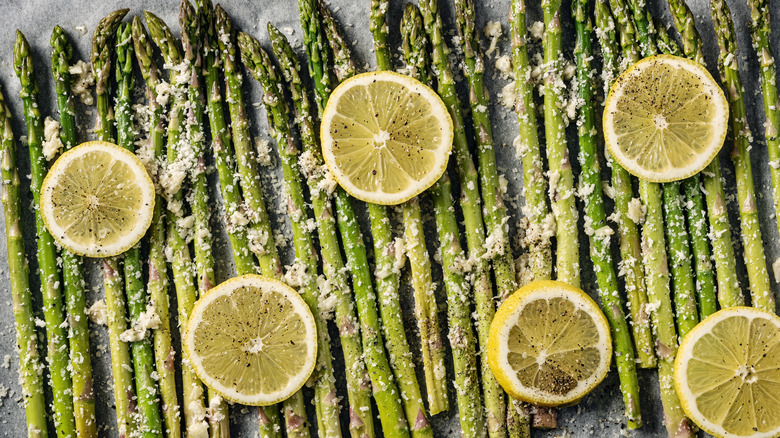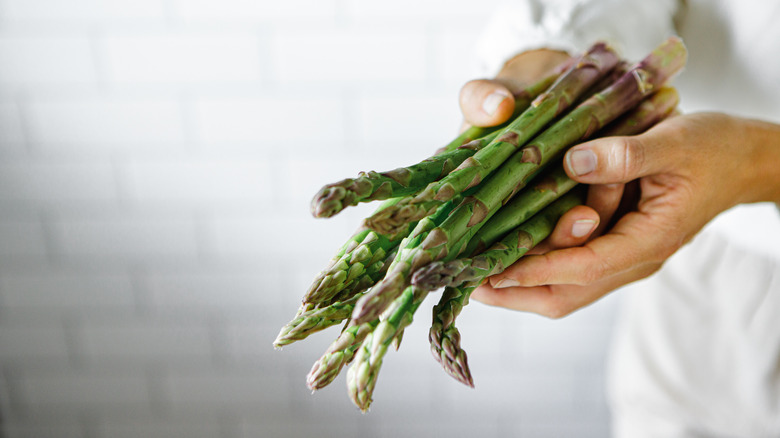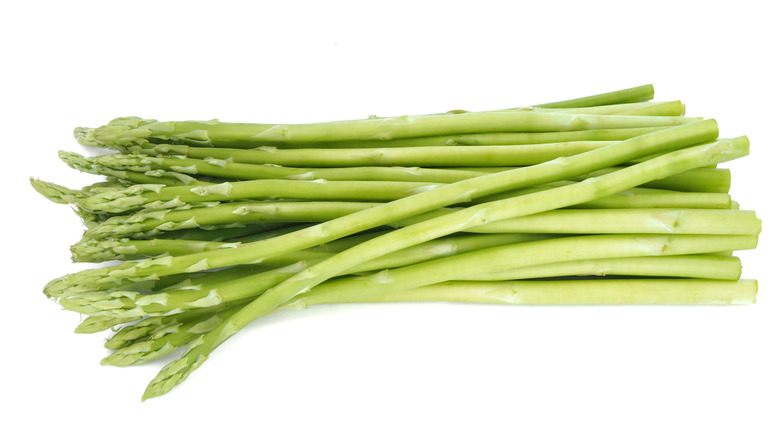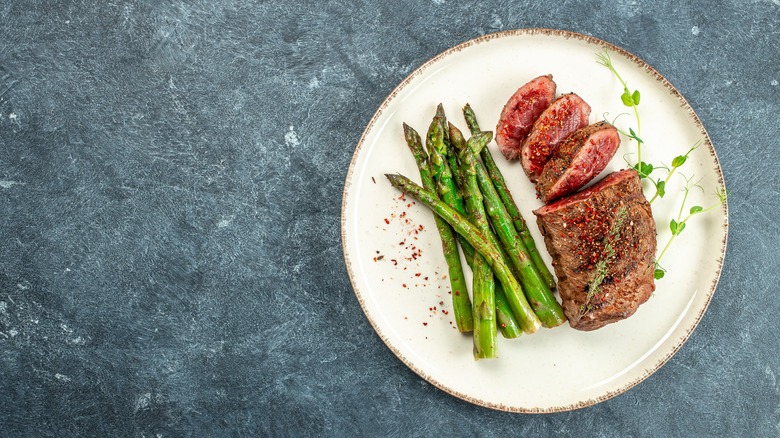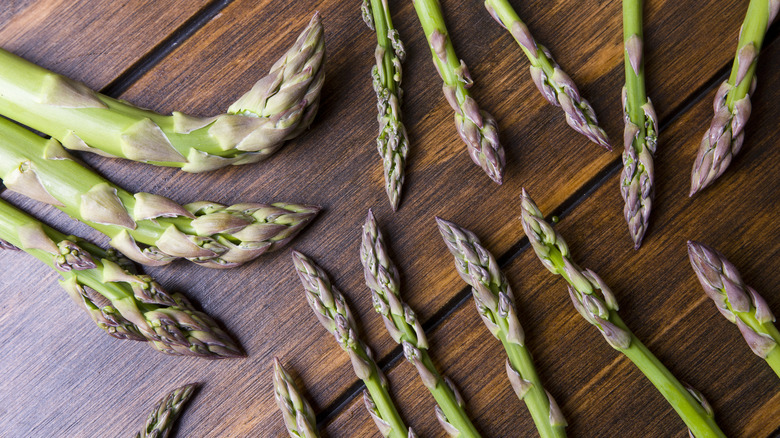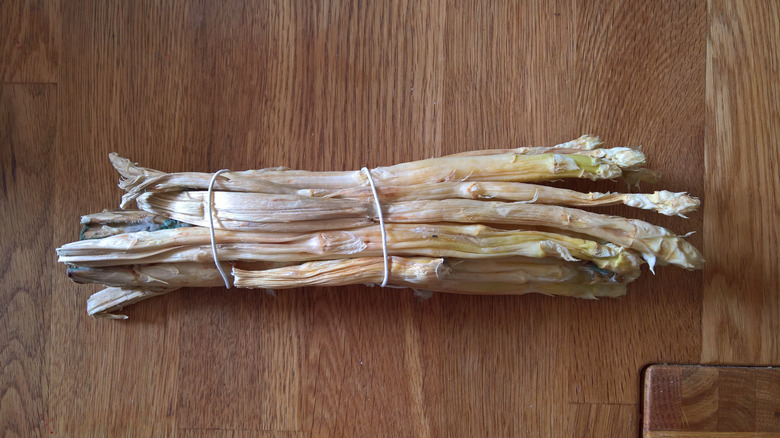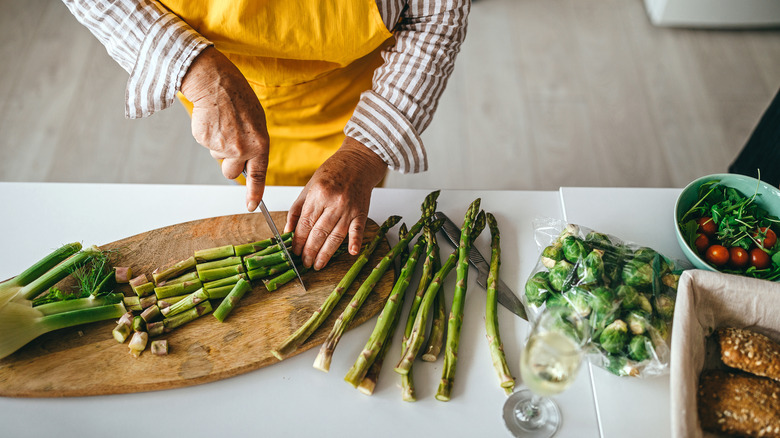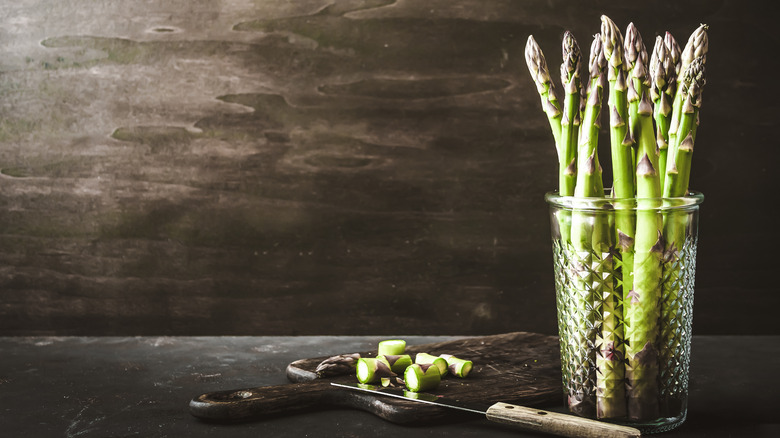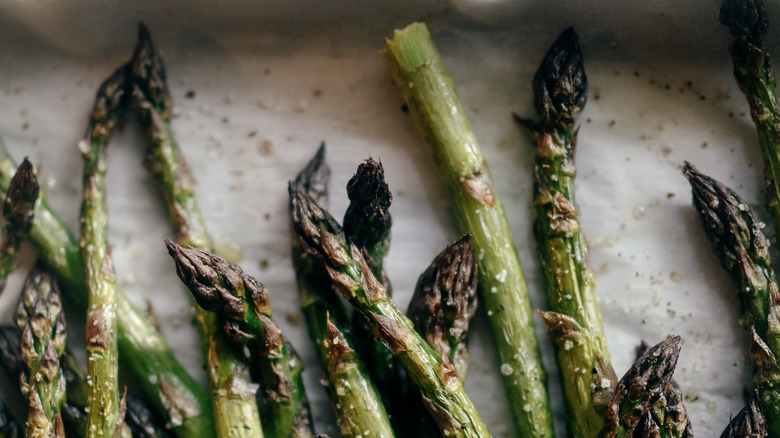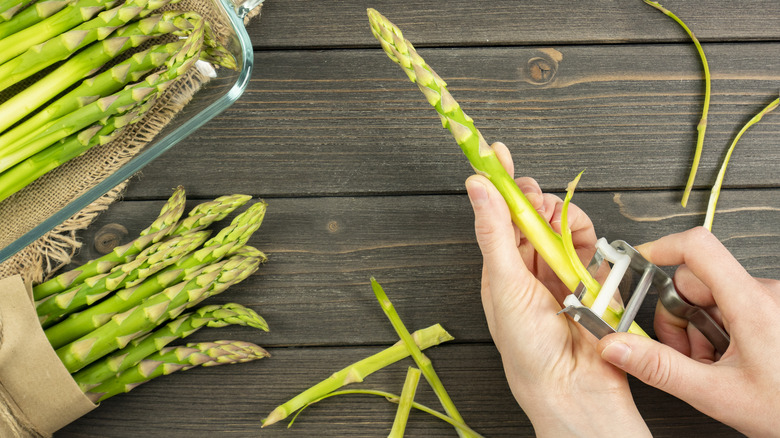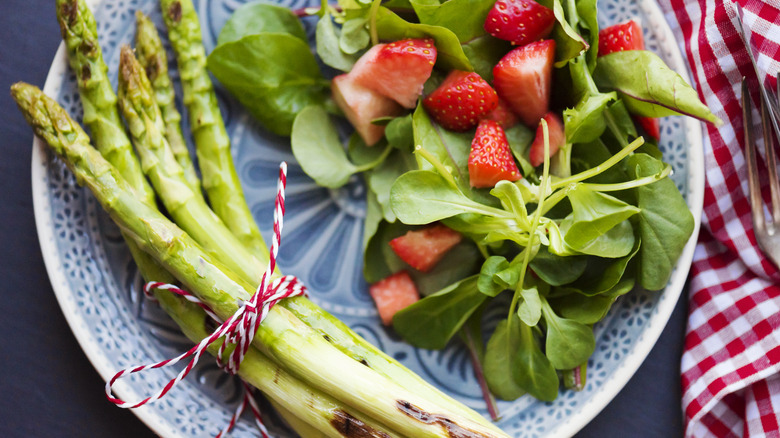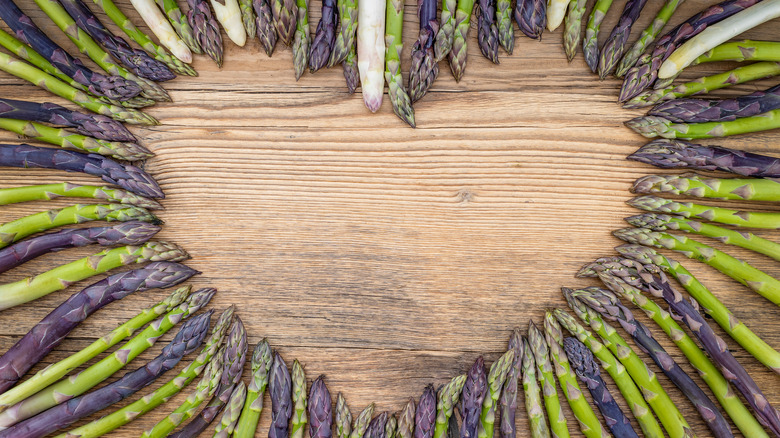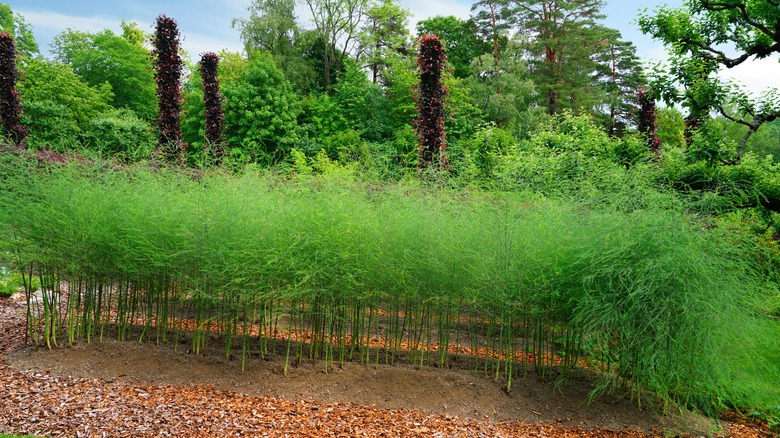13 Mistakes Standing Between You And Perfect Asparagus
Nothing beats the joy of finding a lovely bunch of local asparagus at your neighborhood grocery store in the spring (Or, if you're like this writer, seeing your first struggling asparagus spear come up in the garden). Yet at the same time, nothing is more disappointing than spending money on premium produce, only to ruin it by cooking it carelessly.
This super versatile veggie can star in vegetarian spaghetti carbonara, roasted vegetables, or springtime veggie pot pie, as well as simple side dishes, salads, and soups — but preparing it isn't foolproof. How can you avoid common asparagus mistakes and ensure that your recipes achieve perfection? If you figure out how to treat asparagus the way it wants to be treated — paying mind to its age, thickness, and color — then you won't suffer the disappointment of burnt, soggy, tough, or bitter stalks ever again.
If it sounds odd to personify asparagus, know that different types of this vegetable really do have different needs, which you'll learn about below. Without further ado, here are some of the most common mistakes standing between you and perfect asparagus, and how to sidestep them.
1. Using stalks that are too old or too young
Asparagus age matters. Buying asparagus that is too old is likely to give you fibrous stalks and flower heads that might be opening. This is not to say, however, that young asparagus is always better-tasting or easier to cook with. In fact, younger asparagus is often the more difficult ingredient.
It's true that many younger vegetables are indeed more tender: think carrots, potatoes, broccoli, and spinach (this writer is starting to think that most veggies might actually be more delicate when young). However, the opposite is true of asparagus. These tasty green spears are fibrous on the outside and tender on the inside. The older asparagus grows, the thicker it gets, giving you more supple, sweet real estate inside each stalk (until it gets too old and starts becoming tough again). Younger asparagus, on the other hand, has more skin and fiber to help it grow tall at the beginning of its life, so it is more likely to be stringy than its older cousins.
2. Assuming thinner is better
It's natural to question how we as home chefs came to such an erroneous conclusion about the youth and width of asparagus. The answer is a marketing scheme, mostly. When farmers first plant asparagus plants, they can't harvest anything for a year, and meaty, thick spears don't appear until year three or four. However, farmers these days harvest the less desirable skinny spears that appear in the second year. Rather than wasting this crop, grocery stores have used "gourmet" labels to give the public the perception that daintier, skinnier asparagus is better.
You should beware of stalks that are too small, as they immediately become limp and floppy when cooking, while their fibrous exteriors will stay stringy. You need to keep a close eye on them, and even then it's sometimes impossible to keep them from overcooking — they'll either blacken instantly in the pan or turn to grey mush in water. As such, many sources feel they should be reserved for raw preparations. Whatever the case, don't choose stalks thinner than about ⅜ inches, which is the recommended minimum for harvest.
The thicker-is-better rule doesn't hold true indefinitely, however. You probably want to avoid them as soon as they get that weird, wide look. At that point, they may have gotten too tough and become less attractive on the plate. Look for asparagus that is about ½ inch wide (or slightly larger), as that's a nice size for tenderness without over-aging.
3. Not matching the width to the recipe
Now that you've got the lowdown on thick versus thin asparagus, here's the true skinny: Size doesn't matter as much as how you use it. In other words, asparagus is a very versatile veggie, but you should match it to the recipes for which its width is appropriate. For instance, young asparagus is great when quickly sautéed with flavorings, while middle-aged asparagus is good in pasta. Thick, mature asparagus is best grilled, roasted, or shaved onto salad.
The best way to achieve ideal results is to know your recipe before you head to the store to buy your stalks. Often the recipe will specify asparagus width, which is a good indicator that the author knows their stuff. If it doesn't, then check out the cooking times. Skinny spears are fine for anything that requires a quick blanch or toss in the pan, but look for medium or large if you're cooking along with other veggies or putting your stalks on the grill.
4. Using stalks of different sizes
By the same token as above, you should always match spear size to recipe and cooking time, which means that mixing fatter and thinner spears is a bad idea. Some will be undercooked and overly crunchy, while others will be overcooked, gray mush. If you can't get enough of the same size, the best bet is to switch up your plans — for example, you could make a salad with shaved asparagus on it rather than an asparagus-only dish.
The other option if you have asparagus of different sizes is to blanch it according to its size, then cut it up and use it in your recipe without further cooking. For instance, you can use blanched spears tossed into pasta or to top a salad, or wrapped in cold prosciutto for a charcuterie board. However, you should be wary of anything that involves a lot of additional cooking time, such as quiche or soup. Note that blanching times will vary by asparagus size. Small spears only take about two minutes, while larger spears need more like four. And never forget your ice bath.
5. Buying second-rate asparagus
We're all human. It's easy enough to fall behind on your plans and take a second-best approach to your dinner plans, but don't do that with asparagus. If you get to the farmers market late, buy second-rate spears at a conventional grocery store, or choose limp, old bunches, you'll be sorry. And not just at the dinner table — some sources say less fresh spears lead to worse-smelling pee. Since even normal asparagus pee is annoying to deal with, this is best avoided (Oh, and if you think you don't have it, think again; a third of people just can't smell it, but that doesn't mean it's not happening).
You can minimize unfortunate flavors and consequences by buying fresh, local bunches from the farmers market, a roadside stand, or your local grocery store. You can tell asparagus is fresh if you take a spear and hold it upright and it stands up straight. It should also be a bright green, transitioning to white toward the bottom. Look for closed tips, firm stalks, and even color overall.
6. Prepping too far in advance
It's tempting to prep veggies well in advance for a festive dinner ... or if you're one of those admirable people who does the shopping on Sunday and then spends hours chopping and sorting (Please, teach the rest of us how to be one of those people). However, this can lead to suboptimal results for your spears.
Why? Because if you prep your asparagus too far in advance, you will just make the stalk drier. It was already trimmed and had to scab over once. Don't create more opportunities for moisture loss by cutting off the ends too soon. It will likely lead to wilting, toughness, and a poorer overall result.
The good news is, if you do accidentally dry out your asparagus, you can rehydrate it before cooking. If you really feel the need to trim the stems ahead of time, use the flower method and store your asparagus in a jar of water in the fridge.
7. Failing to soak before cooking
If you've just purchased your asparagus from a farmers market, brought it home from the garden plot, or harvested it in your backyard, you can freely skip soaking. As long as the spears pass the color and firmness tests, you're good to go.
However, by the time you get asparagus from the regular grocery store, chances are it's been sitting around a while. Asparagus, being seasonal, may be a lot fresher if it's local. If it has shipped from the bottom of the world (like Argentina), however, chances are it's not newly harvested. Although it's impossible to give an exact timeframe, that's a distance of about 9,000 kilometers to get to the U.S.
That's a long journey on which asparagus can dry out, so soak your spears. Luckily, it's easy enough to rehydrate them. Just remove the woody part of the stem and plunk the asparagus in water for about 5 minutes, making it nice and crisp once more. Just don't soak too long or it might get soggy. Note that if you've stored asparagus spears in a jar of water in the fridge, this isn't necessary.
8. Not questioning the snap method
All right, let's get controversial. The snap method is something many home cooks grew up learning: take a stalk in your hands and gently bend it until it breaks. That's the natural point at which the asparagus becomes woody, so you can discard the bottom and safely cook the top ... right?
Well, maybe not. Where the stalk snaps has to do with a lot of factors, such as freshness, thickness, and your personal snapping approach. You won't hurt your asparagus by doing this, but you might be wasting a whole lot of usable produce. Further complicating matters is the myth that thinner asparagus is more tender, which makes some folks think you don't have to trim it at all. But that's not true; all asparagus has a woody base, even though some thin stalks simply don't snap when you bend them.
The proper way to trim any stalk of asparagus is to cut where the stalks transition from green to white. If you're going to cut them in batches, then make sure to line them up by this transition point, not by the bases, which is arbitrary. That way, you'll always remove the right amount of stem and avoid chewing that hateful asparagus cud.
9. Overcooking it
Asparagus overcooks quickly, and as soon as it does, it becomes an evil-smelling mush. Asparagus should still have some crunch to it as well as a lingering bright green hue. Look for the color of fresh grass or leaves, not military green. It must still have some brightness left, or the only texture relieving the mushiness will be the stringiness. It's particularly important to keep your eye on the prize because asparagus will continue to cook after being removed from the heat.
In order to avoid overcooking, you can always use the blanch and shock method. Remember to vary cooking times based on the size of the spears: two minutes for small spears, four minutes for large spears. As soon as you remove spears or chunks from the water, put them straight into the ice bath. This is a great technique to keep your spears crunchy and bright green for salads. It also works well if you're making something like a stir-fry where the ingredients will not spend much time on the heat.
If you're going to pan-fry, grill, or broil, avoid the low-and-slow approach. The insides are likely to overcook before you get a nice sear on the exterior. Instead, cook asparagus at high heat to get some caramelization and blackening on the outside without losing structural integrity, then remove the spears even if they might be slightly underdone. Be vigilant: by the time you can smell asparagus, you've likely overcooked it.
10. Not peeling it
This is a matter of some debate. Many online sources advise peeling to remove tough outer skin, the same as you would with a stalk of broccoli. Others advise leaving it on and removing as much of the bottom as you need to in order to avoid the tough skin. Since even the experts disagree, it's safe to leave this up to personal judgment.
However, if you haven't even tried peeling asparagus, you should. It's as easy as it sounds. All you do is take an ordinary vegetable peeler (or a sharp knife if you prefer paring) and remove the outer layer of skin from the bottom of the asparagus, where it starts to look tough and fibrous. Try not to remove any of the inner flesh, since even at the bottom of the stalk, it is sweet and tender.
When you use the peel method, you may find yourself able to finally leave the bend-and-snap technique behind. All you have to do is cut off the very woody bottom and, if that still leaves too much tough skin, peel to remove it. You may waste less of the stalk this way.
11. Failing to experiment
Asparagus is good in so many different ways. Many folks find one preparation method that they like and stick with it, but you're selling yourself short if you do that. Even if you have a go-to recipe that everyone loves (hopefully one involving some wrapped bacon), you should still experiment in the kitchen and branch out.
This is especially true if you haven't yet tried eating it raw. So many people believe it must be cooked, so they exclusively take the heat-based approach, but raw asparagus has so much potential. If you haven't yet tried a shaved or chopped asparagus salad, you're missing out. It's super yummy sliced thinly on the diagonal and dressed with olive oil, salt, and lemon juice. You can even use it shaved on crostini or flatbread.
Don't neglect interesting flavor combinations. Grilled asparagus with parmesan and honey mustard is delicious, as is chilled asparagus vichyssoise, subbing out traditional allium flavors for the spears' delicate sweetness. Sheet pan asparagus with chicken sausage is an easy one-pan style dinner. You can even cook asparagus in the air fryer for a crispy snack.
12. Forgetting about white and purple asparagus
Did you know that there are actually three colors of asparagus? It's true, and you've likely seen at least one alternate variety at the grocery store or farmers market, even if you might not have realized it because you weren't looking for it. There's green, of course, but there is also purple and white asparagus.
White asparagus is simply green asparagus that is grown in complete shade or underground. Asparagus is green for the same reason that most plants are: the compound chlorophyll. It's a naturally occurring pigment that develops when plants have access to sunlight. When asparagus is deprived of light, it never develops that pigment, leading to a ghostly white variety. It's delicious with hollandaise, tahini-lemon sauce, or served with potatoes and ham German-style.
Then there's purple asparagus. This cultivar of asparagus is a lovely violet color all the way down the stalks, though it does get lighter at the ends like green asparagus does. It was first cultivated in Italy but can now be found all over the world. In addition to being lovely, it contains 20% more sugar than other varieties, so it's even sweeter and more tender.
13. Not growing it yourself
Asparagus is actually quite easy to grow yourself. As long as you have well-drained soil in full sun, you can have a thriving patch in just a few years. It is a perennial vegetable that will reliably produce year after year from the same plants, and it's fun to see what asparagus looks like in the "wild." Unharvested spears grow into 3- to 4-foot-tall ferns with waving green fronds, and the female plants eventually develop red berries in summer.
If you're going to grow it yourself, you'll want to buy crowns online. These are bare root bundles that look like weird, many-fingered hands. You should plant them between 5 and 8 inches deep. In heavy soil, opt for a shallower planting depth; in cold areas, go deeper. While asparagus will come up the first year, make sure to wait on harvesting for at least a year to allow the roots to get established. Asparagus plants last 15 years or more, so you'll enjoy the fruits of your labor for many years to come.
